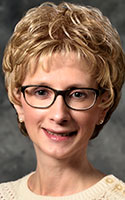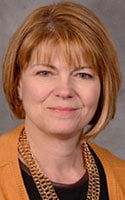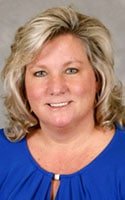The job may have changed, ‘but the heart of it stays the same’
By Mary Beth Roach

As the nation starts to come out of the dark days of the COVID-19 pandemic, we prepare to honor nurses during National Nurses Week in May. We talked with the heads of nursing departments at several area hospitals about the profession, the impact of the pandemic, the shortage of nurses nationwide, and the future of nursing.
Nancy Page, chief nursing officer with Upstate University Hospital, Melissa Purtell, director of nursing for Oswego Health at Oswego Hospital and Lynne Shopiro, interim chief nursing officer at Crouse Hospital, have a combined sum of at least 100 years of service in the nursing profession.
In their current roles, Page oversees a nursing staff of about 3,000 across all levels of nursing. At Crouse, Shopiro’s team numbers about 900 RNs and 150 nursing assistants. Purtell is responsible for 152 RNs between the hospital, emergency department and its two urgent care centers.
The three say the skilled nursing is gratifying, makes a true difference, and offers the ability for professional growth.
“There’s nothing more rewarding than helping your fellow man. You help people every single day. It truly is so rewarding. I don’t think I could do it for 30 years if I didn’t feel that way about it,” Purtell said.
Page also sees great flexibility and opportunities for professional growth in the profession especially for those who completed a doctor of nursing program. It “molds and reshapes itself. You, as a nurse, can mold and reshape yourself,” she said.
The pandemic’s impact

The biggest challenge facing nurses recently has been the pandemic. Page, Purtell and Shopiro agree that some nurses are struggling with post-traumatic stress.
Patients couldn’t have family members or friends visit during this time, so a nurse “might be the only person at the bedside when this person dies. You feel their pain. You wanted to have their family in. You knew why they couldn’t be. I think that is causing enormous stress on nurses today,” Page said.
“It was a long road. There were some really tough times during this,” Purtell said. “Your adrenaline and your anxiety have been going full force for months.”
Now, as some of the surges subside, nursing staffs have to readjust to what their lives were like prior to COVID-19.
For nurses, Shopiro rhetorically asked, “What does life look like now?” She suggested that they reach out to friends, return to hobbies they enjoy and “pause and reflect on the lives that you changed; the lives that you saved.”
Moreover, the three concur that leadership teams need to continue to make their nurses feel supported and to promote their wellness. They also praised their staffs for their care and dedication.
The pandemic could have long-lasting impacts on the nursing profession. While it may cause an increase in the shortage, Page, Purtell and Shopiro are hopeful that people will be inspired by what they saw nurses do over the past 15 months and enter the profession.
Turnover in the field
According to 2021 NSI National Health Care Retention and RN Staffing Report, hospital turnover currently stands at 19.5%, but Upstate, Crouse and Oswego are seeing rates below that number. At Upstate, the rate is at about 14.8%, according to Page. At Crouse, according to Shopiro, the rate for 2020 was 12.5%, and for the first quarter of this year, it’s 11%. Meanwhile, at Oswego Hospital, the turnover rate in 2019 was 17.93%.
Even though Central New York might not be seeing dire shortages, it remains a concern for the profession overall. Page suggested several factors contributing to it.
The healthcare needs of the country are changing as baby boomers, those born between 1946 and 1964, age. According to the U.S. Census Bureau, the boomers are the second largest generation of living adults, behind millennials.
To alleviate the shortage at some medical facilities, travel nurses are often hired to fill in temporarily. Their contracts usually run 13 weeks and some of the ads on the internet claim these nurses could make $51,000 for that time period. It is difficult for some hospitals to compete with such lucrative salaries, Page noted.
A nurse’s work schedule can also be challenging for some. For hospital-based nursing, most of the positions are not the typical 9 to 5, Monday through Friday. These facilities have to be adequately staffed seven days a week, 24 hours a day, weekends and holidays included.
In addition, the American Association of Colleges of Nursing has cited a 2018 report that the average age of a registered nurse is 50 years old, which means a significant number of RNs will retire in a few years.
Recruitment and retention

Key to reversing the shortage is in recruiting and retaining nurses. Purtell and Shopiro indicated that a sense of community and the dedication to serve their neighbors play a big role in keeping nurses.
In addition, hospitals have to a presence in any markets that nurses are looking at today, they have to be social media savvy and stay current with technology, for example hosting virtual recruitment events during the pandemic as Upstate has done, Page pointed out.
“I think another piece of retention is investing in their professional development,” she added.
Many hospitals throughout the country will offer tuition assistance programs, and upon completion, the nurses are usually required to work at that healthcare facility for a specific length of time, and Crouse offers new graduates an incentive package that does not have a time commitment.
Hospitals, too, are constantly training staff and working with area nursing schools and programs to foster a relationship between the students and their respective healthcare facilities.
At Oswego, Purtell has developed several initiatives aimed at providing hands-on experiences. One such program offers graduate nurses a one-year residency, in which they experience nursing in a variety of departments within the Hospital. Upstate is an academic medical center and offers a variety of specialties for nurses to choose. In addition, Page said, its level 1 trauma center covers a large geographic area, with an extensive range of cases, from farming accidents occurring in the area’s rural communities to the gun violence.
Upstate’s College of Nursing prepares RNs to get their Bachelor of Science degree in nursing, or BSN.
The future
All three are optimistic about the future of the nursing education. Page pointed out that the profession has ranked as being the most trusted profession for years; a 2018 Gallup poll placed nursing as the most trusted profession in the U.S. for the 20th year, with 84% of the respondents rating nurses “very high” for honesty and ethical standards.
As Purtell said, “There’s always going to be a need for nursing. The degree of change from when I started as a nurse to now is unbelievable. The technology may change, policy might change, techniques might change, procedures might change, the heart of it stays the same. That’s not going to change. I can’t wait to see what it looks like 20 years from now.”

